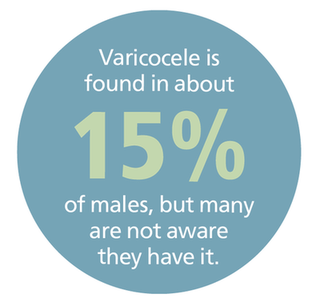| DID YOU KNOW? |
Varicocele
A varicocele (VAR-ih-koe-seel) is an abnormal enlargement of veins within the scrotum (just above the testis). Varicoceles are similar to varicose veins, but they occur around the testicles rather than the legs.
Varicocele is very common, with more than
3 million cases
reported each year in the United States.
Varicocele may run in the family, but is very rare before 10 years of age.
Varicocele rarely causes symptoms. The most common symptoms include:
- Feeling a lump in the scrotum
- Feeling heaviness/throbbing pain in the scrotum if standing for a long period of time

Varicocele is almost always found on the left side of the scrotum. Although the exact reason for why one forms is not clear, some theories tie it to a faulty valve inside the veins or to a different way the main testis vein joins the circulation in the rest of the body.
There are different ways to treat a varicocele. Your provider will be able to help you choose the best approach for your condition.
Nonsurgical repair:
a catheter is used to place a tiny coil and/or embolic fluid in a blood vessel to divert blood flow away from a varicocele.
Surgical repair:
a small incision is made in the abdomen close to where the testicles originally descended through the abdominal wall. The veins that produce the varicocele are identified and cut to eliminate blood flow to the varicocele.
Varicocele is the most common cause of male infertility. About 20% of males with varicocele are at risk of infertility. The good news is that the chance of being fertile is 80%.
This means most males with varicocele do not require surgical repair.
Several tests can help your provider tell whether you are at risk for infertility. These tests can include an ultrasound and/or semen analysis. Semen analysis is only advised for males above 16 years of age.
For more information, visit
Urologyhealth.org/Varicocele.
UrologyHealth.org | SPRING 2018 | UROLOGYHEALTH extra